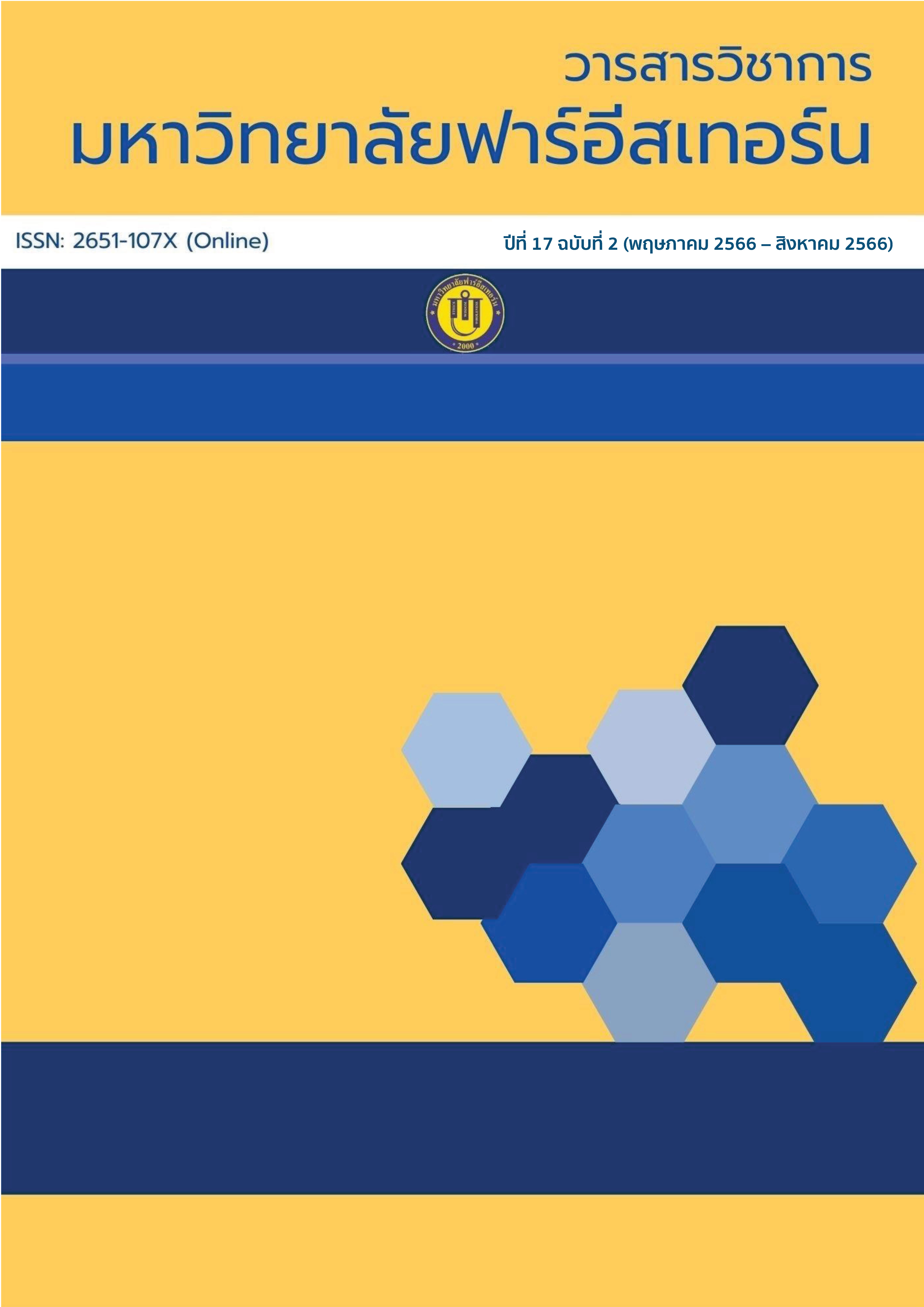The Confirmatory Factors Analysis on Country Reputation of Thailand
Main Article Content
Abstract
The purpose of this research are to 1) examine the confirmatory factors analysis in country reputation of Thailand. 2) To evaluate the alignment of the model with the characteristics of Thailand's reputation. The quantitative research were consisted of 800 respondents are Thai residences in 9 provinces by cluster sampling from 4 religions such as: Chiangmai, Lampang, Ubon Ratchathani, Nakhon Phanom, Phitsanulok, Pathum Thani, Surat Thani, Krabi and Bangkok by especially area. The questionnaire alpha coefficients ranged from 0.824-0.936. Descriptive statistics were analyzed by social science statistics while confirmatory and factor analysis and structural equation model were analyzed by LISREL. The results were as follows: the country reputation of Thailand overall is at moderate level. The social appeal element has highest mean at a high level. Next is the physical appeal element at a high level. The developed model fitted the empirical data by (x2 =591.78; df=220; P-value=0.00; RMSEA=0.044; RMR=0.034; SRMR=0.040; GFI=0.96; CFI=1.00. The elements that can indicate the country reputation of Thailand the most are: the leader appeal element at 98 percent (R2=0.98, b=0.92). Next is the social appeal element at 97 percent (R2=0.97, b=1.03). The third is safety appeal element at 87 (R2=0.87, b=0.96).
Article Details

This work is licensed under a Creative Commons Attribution-NonCommercial-NoDerivatives 4.0 International License.
1. Any views and comments in the Journal of Social Innovation and Lifelong Learning are the authors’ views. The editorial staff have not to agree with those views and it is not considered as the editorial’s responsibility.
2. The responsibility of content and draft check of each article belongs to each author. In case, there is any lawsuit about copyright infringement. It is considered as the authors’ sole responsibility.
3. The article copyright belonging to the authors and The Far Eastern University are copyrighted legally. Republication must be received direct permission from the authors and The Far Eastern University in written form.
References
การท่องเที่ยวแห่งประเทศไทย. (2563). การศึกษาแนวโน้มและทิศทางการท่องเที่ยวไทยในปี พ.ศ.2563. กรุงเทพมหานคร: กองวิจัยการตลาด การท่องเที่ยวแห่งประเทศไทย.
ณัฐวิชช์ ดำรงศรีวงศ์. (2564). พัฒนาการลักษณะการมีส่วนร่วมทางการเมืองของประชาชน. วารสารวิชาการไทยวิจัยและการจัดการ, 2(1), 61-71. https://so05.tci- thaijo.org/index.php/TRDMJOPOlSU/article/view/252039
นันทินี สันติธรรม. (2560). การนำเสนอภาพของศิลปวัฒนธรรมไทยผ่านละครโทรทัศน์ [วิทยานิพนธ์ปริญญามหาบัณฑิต, มหาวิทยาลัยธรรมศาสตร์]. http://ethesisarchive.library.tu.ac.th/thesis/2017/TU_2017_5907011471_8184_9151.pdf
ประสิทธิ์ ปิวาวัฒนพานิช. (2562). แนวทางการพัฒนากฎหมายให้สอดคล้องกับหลักสากลตามบทบัญญัติของรัฐธรรมนูญ (บทสัมภาษณ์ความเห็นทางวิชาการ). จุลนิติ, 16(2), 3-11.https://library.senate.go.th/document/Ext21733/21733771_0002.PDF
พระครูปลัดประวิทย์ วรธมฺโม, พระครูใบฎีกาศักดิ์ดนัย สนฺตจิตฺโต และ สัญญา สดประเสริฐ. (2564). การนำหลักธรรมาภิบาลมาใช้กับการบริหารงานภาครัฐ. วารสารมหาจุฬานาครทรรศน์, 8(4), 35-47.https://so03.tci-thaijo.org/index.php/JMND/article/view/251622
เสกสรรค์ สนวา, สุพัฒนา ศรีบุตรดี, พงศ์สวัสดิ์ ราชจันทร์ และ นภัสภรณ์ ภูวตานนท์ ณ มหาสารคาม. (2563). การจัดการแหล่งท่องเที่ยวเชิงวัฒนธรรมตามวิถีชีวิตของคนในชุมชน. วารสารการบริหารการปกกครองและนวัตกรรมท้องถิ่น, 4(1), 259-276. https://so03.tci-thaijo.org/index.php/JLGISRRU/issue/view/16423
เสรี ชัดแช้ม. (2547). การวิเคราะห์องค์ประกอบเชิงยืนยัน. วารสารวิจัยและวัดผลการศึกษา, 2(1), 15-42.
อุดม ไพรเกษตร และ ปิยากร หวังมหาพร. (2560). การมีส่วนร่วมของประชาชนผ่านทางสื่อสังคมเฟสบุ๊คของหน่วยงานภาครัฐ. วารสารการเมืองการปกครอง, 7(1), 39-59. https://so03.tci-thaijo.org/index.php/jopag/article/view/147534
Berens, G., Fombrun, C.J., Ponzi, L.J., Trad, N.G. & Nielsen, K. (2011). Country RepTrak™: A Standardized Measure of Country Reputation. In: Go, F.M., Govers, R. (Eds.) International Place Branding Yearbook 2011. Palgrave Macmillan, London.
Country RepTrak. (2012). 2012 Country RepTrak™ Top line Report. www.tfsa.ca/storage/reports/2012_Country_RepTrak_Topline_Report.pdf
Christelis, D. (2006). Country reputation management: Identifying the drivers of South Africa’s reputation in German media [Master’s Thesis, University of Stellenbosch].
Frobes. (2019). The World’s Most Reputable Countries 2019.https://www.forbes.com/sites/vickyvalet/2019/10/15/the-worlds-most-reputable-countries-2019/?sh=4bfac95f4cb8
Fullerton, J. & Holtzhausen, D. (2012). Americans’ attitudes toward South Africa: a study of country reputation and the 2010 FIFA World Cup. Place Branding and Public Diplomacy, 8(4), 269-283.https://link.springer.com/article/10.1057/pb.2012.19
Hooper, D., Coughlan, J. & Mullen, M. (2008). Structural equation modeling: guidelines for determining model fit. Electronic Journal of Business Research Methods, 6(1), 53-60.https://www.researchgate.net/publication/254742561_Structural_Equation_Modeling_Guidelines_for_Determining_Model_Fit
Jain, R. & Winner, L. (2013). Country reputation and performance: The role of public relations and news media. Place Branding and Public Diplomacy, 9(2), 109–123. DOI:10.1057/pb.2013.7
Kelley, J., Hemphil, A. & Thams, Y. (2019). Corporate social responsibility, country reputation and corporate reputation: A perspective on the creation of shared value in emerging markets. Multinational Business Review, 27(2), 178-197. https://doi.org/10.1108/MBR-07-2017-0047
Kiambi, D. & Shafer, A. (2018). Country reputation management: Developing a scale for measuring the reputation of four African countries in the United States. Place Branding and Public,14(3), 175–186. https://link.springer.com/article/10.1057/s41254-017-0065-7
Marino, V. & Mainolfi, G. (2013). Country reputation and attitudes towards made in Italy products: a study on Chinese consumers. International journal of Chinese culture and management, 3(3), 228-241.https://doi.org/10.1504/IJCCM.2013.055420
Newburry, W. (2012). Waving the flag: the influence of country of origin on corporate reputation. The Oxford Handbook of Corporate Reputation.
Reputation institute. (2023). Global RepTrak™ 100. https://www.reptrak.com/
Szwajca, Danuta. (2017). The Importance of Reputation of A Country in the Process of Building its Competitive Advantage on The Global Market. Scientific Journal, 21(7), 99-114.https://asej.eu/index.php/asej/article/view/437
Yang, Sung-Un; Shin, Hochang; Lee, J. H. & Wrigley, B. (2008). Country Reputation in multidimensions: Predictors, Effects, and Communication Channels. Journal of Public Relations Research, 20(4), 421-440.https://doi.org/10.1080/10627260802153579
Yousaf, S. (2017). Quantification of country images as stereotypes and their role in developing a nation brand: The case of Pakistan. Place Branding and Public Diplomacy, 13(1), 1-15.https://link.springer.com/article/10.1057/pb.2015.22
Yousaf, S. & Li, H. (2015). Social identity, collective self-esteem and country reputation: the case of Pakistan. Journal of Product & Brand Management, 24(4), 399-411. https://doi.org/10.1108/JPBM-04-2014-0548
Yousaf, S. & Samreen, N. (2015). Information agents and cultural differences as determinants of country’s reputation and its subsequent effects on tourism prospects of a country in sustained crises: The case of Pakistan. Journal of Vacation Marketing, 22(4), 1-20https://doi.org/10.1177/1356766715623828

